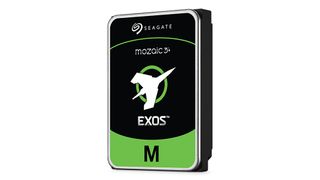Seagate Unveils 32TB HDD: A Record-Breaker with Controversial SMR Tech
Seagate's new 32TB hard drive, utilizing SMR and HAMR technologies, pushes storage boundaries but raises performance concerns.

Shortly after Western Digital released a 32TB drive of the same type, Seagate unveiled their largest hard drive to date, a 32-terabyte (TB) unit in the Exos M series.
A 30TB model (ST30000NM004K) with Conventional Magnetic Recording (CMR) and a 32TB model (ST32000NM003K) with Shingled Magnetic Recording (SMR) are the two capacities available in the Exos M series. By overlapping data tracks, SMR expands storage capacity, enabling more data to fit on the disk. Experts disagree about this approach since it may result in slower writing speeds and more complicated data management.
With a SATA III interface, these drives can carry data at up to 6 gigabits per second (Gbps). They are built on Seagate's Heat-Assisted Magnetic Recording (HAMR) platform paired with Mozaic 3+ technology. HAMR employs laser heating to offer better data density without losing dependability. Despite initial criticism regarding HAMR's readiness and reliability, Seagate cites a mean time between failures (MTBF) of 2.5 million hours for these drives, suggesting high durability.
In comparison to standard versions, Seagate highlights that the new drives provide three times the power efficiency per terabyte, which lowers operating costs and advances sustainability objectives. Additionally, compared to earlier Seagate products, the Exos M series is built with more recycled materials and renewable energy.
This release comes nearly a year after Seagate debuted its previous largest drive, a 30TB unit in the Exos line. In order to satisfy the rising demand for high-capacity storage solutions in data centers and enterprise settings, the company intends to increase production of its HAMR-based drives in 2025.
Content & Picture Credit: Information sourced from TechRadar.







